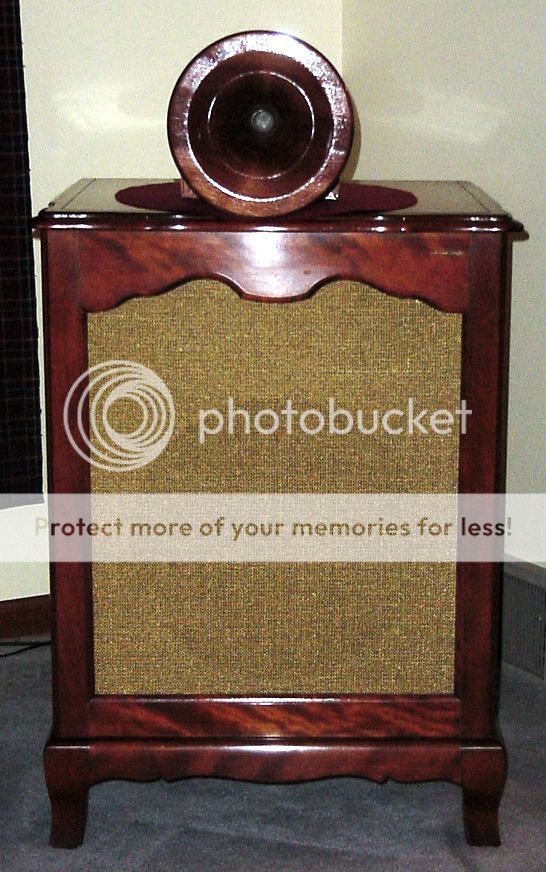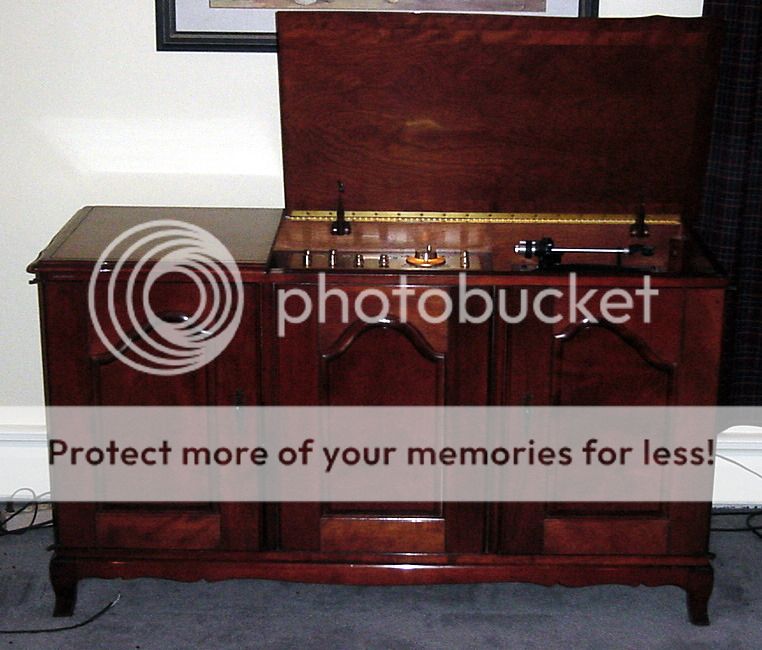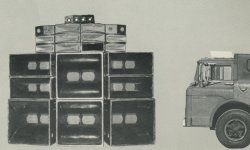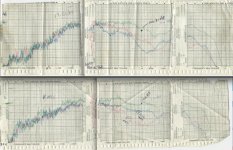I’m thinking of trying to do something where I should probably know better…
Goal is mid bass 100-500hz. Straight front loaded horn, no folds.
Constraint: a pair WAF compliant vintage “hi-fi furniture” cabinets.

Large by WAF standards, but available mouth opening is only 2450 cm^2 (17.25” wide by 22” high). Depth is not an issue but would like to keep it < 4 feet (122cm) or so.
Experimenting with Hornresp says… maybe?
Looking at the Volvotreter 77hz conical horns (EVM 15L)
In Hornresp, 2 pi, reduced throat size and lengthened (old AA thread by “green heron”); with my mouth size gives the expected ripple from too small a mouth, but all within a 2.5db spread 90-600. Looks like I could cross at 100 and 500


I also looked at the Inlow 100hz conical horns (B&C 12pe32) - mouth size very close to my constraint. But modeled in 2 pi the added complexity does not appear to give me any advantage over the modified Volvotreter horn, and it doesn’t go as low. (Inlow website graph looks like 1 pi results).
My wife would LOVE it if I could shove the cabinets in a corner, so my loading might really be closer to 1 pi but I won’t bank on it.
So, my question for the experts – is this a viable horn, or if not a (pick one or more)
- Honking
- Shrieking
- Rasping
- Beaming
- Colored
piece of crap?
FYI, where I am thinking of going with this:
38-100 Volvotreter 38hz Tang Band tapped horns (pair for stereo)
100-500 front horn (rectangular)
500-5000 round tractrix (likely Autotech, would love wood but Bruce Edgar retired and I can’t DIY them)
5000+ JBL 076 (maybe not the best, but I got ‘em and they’re cool!)
I should be able to time align
Current system – JBL 136a in reflex cabs, 650hz Edgar salad bowls with 2420 crossed @ 800, 076 cat eyes. DIY PP 6B4G amps.
Goal is mid bass 100-500hz. Straight front loaded horn, no folds.
Constraint: a pair WAF compliant vintage “hi-fi furniture” cabinets.

Large by WAF standards, but available mouth opening is only 2450 cm^2 (17.25” wide by 22” high). Depth is not an issue but would like to keep it < 4 feet (122cm) or so.
Experimenting with Hornresp says… maybe?
Looking at the Volvotreter 77hz conical horns (EVM 15L)
In Hornresp, 2 pi, reduced throat size and lengthened (old AA thread by “green heron”); with my mouth size gives the expected ripple from too small a mouth, but all within a 2.5db spread 90-600. Looks like I could cross at 100 and 500


I also looked at the Inlow 100hz conical horns (B&C 12pe32) - mouth size very close to my constraint. But modeled in 2 pi the added complexity does not appear to give me any advantage over the modified Volvotreter horn, and it doesn’t go as low. (Inlow website graph looks like 1 pi results).
My wife would LOVE it if I could shove the cabinets in a corner, so my loading might really be closer to 1 pi but I won’t bank on it.
So, my question for the experts – is this a viable horn, or if not a (pick one or more)
- Honking
- Shrieking
- Rasping
- Beaming
- Colored
piece of crap?
FYI, where I am thinking of going with this:
38-100 Volvotreter 38hz Tang Band tapped horns (pair for stereo)
100-500 front horn (rectangular)
500-5000 round tractrix (likely Autotech, would love wood but Bruce Edgar retired and I can’t DIY them)
5000+ JBL 076 (maybe not the best, but I got ‘em and they’re cool!)
I should be able to time align
Current system – JBL 136a in reflex cabs, 650hz Edgar salad bowls with 2420 crossed @ 800, 076 cat eyes. DIY PP 6B4G amps.
I would be tempted to build Tune Audio clones. Vertical down firing bass horn.
![url].](/community/proxy.php?image=http%3A%2F%2FImage+from+%5Burl%5Dhttp%3A%2F%2Fi274.photobucket.com%2Falbums%2Fjj263%2Fdurant24%2FIMG_6202.jpg%5B%2Furl%5D.&hash=d680f46401d668e69e3e838955e8bd7a)
An externally hosted image should be here but it was not working when we last tested it.
![url].](/community/proxy.php?image=http%3A%2F%2FImage+from+%5Burl%5Dhttp%3A%2F%2Fi274.photobucket.com%2Falbums%2Fjj263%2Fdurant24%2FIMG_6202.jpg%5B%2Furl%5D.&hash=d680f46401d668e69e3e838955e8bd7a)
Last edited:
I did a sim of the 100 hz Inlow horn in Hornresp and despite the added complexity it didn't really sim any better that the truncated Volvotreter design at 2 pi. And it didn't go quite as low.
The sims graphs on the Inlow site appear to be 1 pi. I might get 1 pi in my room shoved in the corners but I don't want to bank on it and end up failing.
The sims graphs on the Inlow site appear to be 1 pi. I might get 1 pi in my room shoved in the corners but I don't want to bank on it and end up failing.
beancounter,
Simulations don't tell the entire story. A mid bass horn going up to the 500hz is actually in the lower midrange and from personal experience, an exponential or tractrix horn sounds better. I would go for the Inlow mid bass horn. Make your horn as large ( wife friendly ) as possible.
Simulations don't tell the entire story. A mid bass horn going up to the 500hz is actually in the lower midrange and from personal experience, an exponential or tractrix horn sounds better. I would go for the Inlow mid bass horn. Make your horn as large ( wife friendly ) as possible.
While you are waiting for the snow, you might consider 1/2 of these designs which would be close to your cabinet size:Thanks to all for the input. I think I'll try an exponential horn as big as I can get into the cabinet and see how it works.
It will be a good project for when the snow comes.
https://soundforums.net/threads/12075-60-Degree-DIY-Mid-Hi
https://soundforums.net/threads/11317-New-DIY-Mid-High
Djk has a nice sim of a reactance annulled dual 12" in a lascala (2' cube).
Lascala is too small of a mouth causing a rippled response, but if you get the back chamber just right, you can get it smoother. Otherwise a true 100hz horn would be 8ft2 mouth in mid air, 4ft2 middle of concrete floor (so I'd say 6ft2) and 1/4 wavelength of 1/2 octave below mouth (75hz or 3.75' deep).
I'd sim 3pi (but not possible) because 4pi is mid air and 2pi would be the mouth exiting at the middle of a concrete floor. Maybe a mouth on a concrete floor and concrete wall would be close to 2pi sim.
Lascala is too small of a mouth causing a rippled response, but if you get the back chamber just right, you can get it smoother. Otherwise a true 100hz horn would be 8ft2 mouth in mid air, 4ft2 middle of concrete floor (so I'd say 6ft2) and 1/4 wavelength of 1/2 octave below mouth (75hz or 3.75' deep).
I'd sim 3pi (but not possible) because 4pi is mid air and 2pi would be the mouth exiting at the middle of a concrete floor. Maybe a mouth on a concrete floor and concrete wall would be close to 2pi sim.
Did a little bit of fiddling around in Hornresp
- calculated an exponential horn and exported the values
- approximated the exponential with a 3-section conical (kind of like Inlow did with his 2 section conical)
- added a compression chamber (like the Inlow)
- changed to a JBL 2220 driver from the EVM 15L
first pass sim



This Hornresp thing is kinda addicting...
- calculated an exponential horn and exported the values
- approximated the exponential with a 3-section conical (kind of like Inlow did with his 2 section conical)
- added a compression chamber (like the Inlow)
- changed to a JBL 2220 driver from the EVM 15L
first pass sim



This Hornresp thing is kinda addicting...
It certainly can be, but realize that Hornresp assumes all speakers respond as a piston, while in reality light cones like the 15L and 2220 have lots of cone breakup and extend much higher than predicted.Did a little bit of fiddling around in Hornresp
- calculated an exponential horn and exported the values
- approximated the exponential with a 3-section conical (kind of like Inlow did with his 2 section conical)
- added a compression chamber (like the Inlow)
- changed to a JBL 2220 driver from the EVM 15L
This Hornresp thing is kinda addicting...
Below are some charts from fiberglass horns built in 1979, using EVM 12L in the low mid horn, and EVM 15L in the bass horns.
Even though a 15L and a 15B will sim very much the same, the 15B was a rather huge improvement as far as bass output and reduced cone breakup distortion.
Art
Attachments
Even though a 15L and a 15B will sim very much the same, the 15B was a rather huge improvement as far as bass output and reduced cone breakup distortion.
Art
Interesting. I have read elsewhere (Edgar quote?) that the 15L goes high and is difficult to tame in a passive crossover; I was planning on an active tube xover anyway.
Will the 15B extend to 500hz without issues?
Living Voice Vox Olympian...
Absolutely gorgeous and makes it to 70 hertz easily
Gorgeous, but anything debuted at the Monaco Yacht Show is certainly out of my pedestrian DIY budget.
Yes, they sound clean well past that.Interesting. I have read elsewhere (Edgar quote?) that the 15L goes high and is difficult to tame in a passive crossover; I was planning on an active tube xover anyway.
Will the 15B extend to 500hz without issues?
We used them in stage monitors at 800 Hz with 2" exit drivers and around 1200 Hz with 1" exit drivers.
here's my old Edgar 100Hz with ~20.5" x 20.5" mouth, 80sq.in. throat and 20" path outdoors with a 2220H (15B is nice in a little Karlson - sine distortion on graph was for the K43 - 2220H ~10dB higher)
An externally hosted image should be here but it was not working when we last tested it.
- Status
- This old topic is closed. If you want to reopen this topic, contact a moderator using the "Report Post" button.
- Home
- Loudspeakers
- Multi-Way
- midbass straight horn, 100-500


